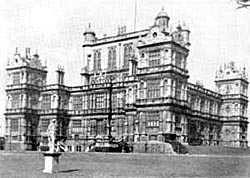< Previous | Contents | Next >
Wollaton Hall
 |
WOLLATON HALL, an extraordinary place whose real name is ‘Olafston,’ came into the hands of the Willoughby family during the first half of the fourteenth century, while Edward Ill. was on the throne. The Willoughbys were the descendants of one Ralph Bugge, a wealthy merchant in Nottingham1 who, having made a fortune, retired to Willoughby-on-the-Wolds early in the thirteenth century and whose family, changing their name to that of Willoughby, have left their mark on Willoughby Church by the wonderful series of monuments which still remain in their mortuary chapel.
The spoilation of the monasteries, and in particular Lenton Priory seem to have further enriched an already wealthy family, and in 1580 Sir Francis Willoughby decided to build himself a new house. He chose an admirable site on a slight eminence providing charming views, and he provided a park of some 790 acres to enclose which it was necessary to destroy the village or hamlet of Sutton Passey. This mansion which Sir Francis built remains to our day, and is now in the possession of the Corporation of the City of Nottingham.
Many learned papers have been written in the attempt to decide the authorship of the design of Wollaton Hall, and the belief held nowadays is that the celebrated John Thorpe was the designer of the general plan. The details were worked out by Robert Smythson who lies buried in Wollaton Church, and the actual details were wrought under the supervision of Italian master masons. The material used in its construction is Ancaster Stone, which was exchanged for coal from Wollaton pits which are first heard of in 1549.
Wollaton must have been an extremely uncomfortable house in which to live, and a heartbreaking house from a servant’s point of view, for all was sacrificed to outside appearances.
The exterior is a mass of enrichment, including busts, medallions and even gondola rings. The whole building is a valuable experiment, and as such worthy of the closest, study. And, moreover, it was a costly experiment, for it cost £80,000 even in the days of the defeat of the Spanish Armada.
The gardens at Wollaton once had the reputation of being the finest in England. The cedars and sycamores are lovely, as are the many specimen trees to be seen in the park. There is a tradition that the first glass house for the protection of plants, erected in England, was built at Wollaton at the end of the seventeenth century.
